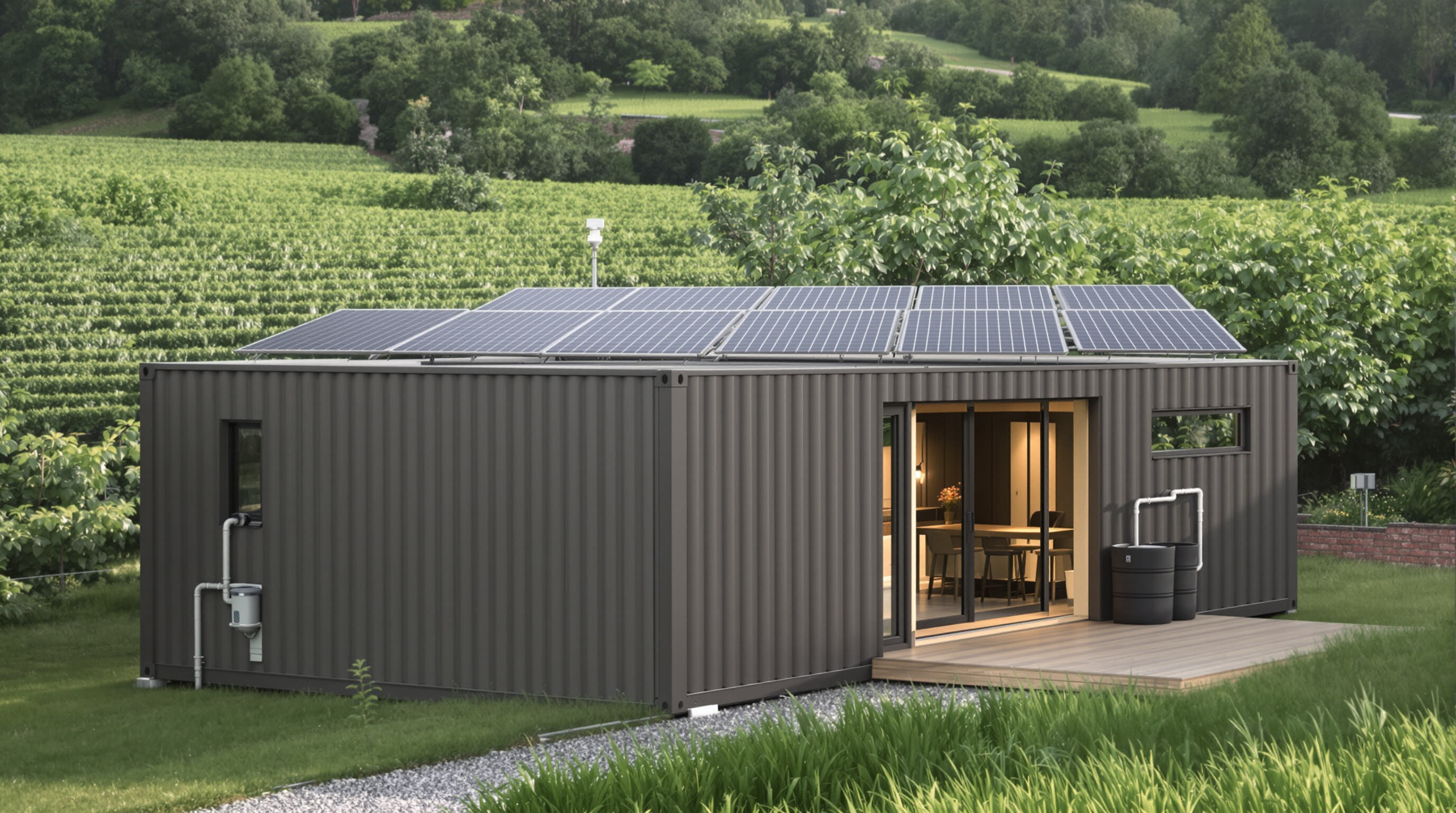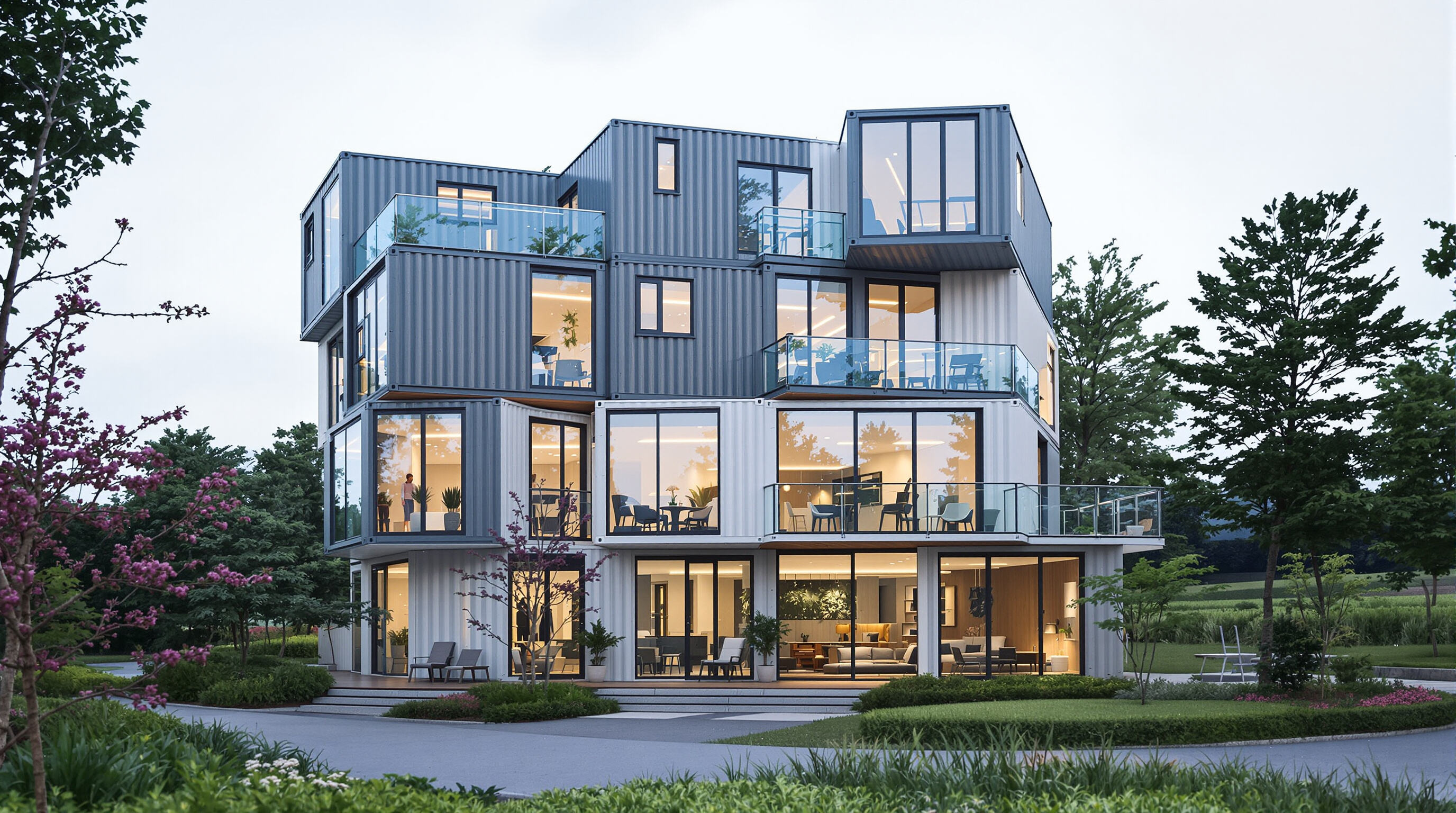The Sustainability and Environmental Impact of Container Houses

Principle: Recycling Shipping Containers for Eco-Friendly Construction
The Circular Economy Report from 2023 says that when we take old steel shipping containers and give them new life, it cuts down construction waste by nearly 97% compared to what happens with regular building methods. Every year around 450 thousand of these retired containers find their way into homes instead of landfills. That means about 8.2 million tons less CO2 gets released because we don't have to make all that new steel. What's really cool about this is how it helps protect forests and saves us from using so much concrete too. Both those things are big players in making our planet warmer. By using something that was already made, we're basically recycling at scale without having to start from scratch.
Energy Efficiency Features: Solar Panels and Rainwater Harvesting Systems
Modern container homes integrate solar panels to offset 60–80% of energy needs, paired with rainwater systems that reduce municipal water consumption by 40% (Renewable Energy Study, 2022). Triple-glazed windows and spray foam insulation deliver 30% better thermal performance than standard drywall construction, significantly lowering heating and cooling costs.
Debate: Are Container Homes Truly Carbon-Neutral?
Recycled steel definitely cuts down on those first round emissions, but some folks argue about all that hidden carbon still stuck in the original shipping containers themselves. We're talking about roughly 1.8 tons of CO2 locked into each unit before anyone even starts building. Still, when we look at how things play out over the long haul, studies from the Urban Sustainability Journal back in 2023 found these container homes actually cut total emissions by around 52% after twenty years compared to regular houses made with bricks and mortar. And get this – if someone installs solar panels or wind power alongside their container home, they can actually balance out all those past emissions in just seven short years. Makes sense why more people are seeing these repurposed containers as something that gets better for the environment the longer they stick around.
Trend: Rising Demand for Sustainable Urban Housing Solutions
Seattle has seen container home permits jump over 200% since 2021, with similar trends popping up in cities like Amsterdam too. Local governments are pushing these changes through zoning rules that make it easier to build with containers. The good news? These container homes actually tackle space issues in crowded cities and cost around 73 percent less in materials compared to traditional apartment buildings. Many municipalities offer financial help now, covering between 15 and 25 percent of total costs when developers meet those green building standards called LEED. This kind of support is making container housing catch on fast among both businesses and regular folks looking for affordable alternatives.
Cost-Effectiveness and Economic Advantages of Container Homes
Affordability Compared to Traditional Home Construction
Container homes offer 30–50% lower construction costs than traditional methods, according to a 2024 market report. Building a 1,000 sq. ft. container home averages $84,000, compared to $140,000+ for conventional wood-frame construction. Savings stem from reduced material needs—repurposed steel containers eliminate 60% of framing materials—and shorter labor timelines (8–16 weeks vs. 6–12 months).
| Cost Factor | Traditional Home | Container Home |
|---|---|---|
| Construction Costs | $140,000 | $84,000 |
| Labor Time | 6–12 months | 8–16 weeks |
| Monthly Utilities | $220 | $150 |
Long-Term Savings Through Reduced Material and Labor Costs
Strategic upgrades like spray foam insulation ($1.50–$3.50/sq. ft.) and solar panel installations ($18,000 avg.) yield energy bill reductions of 25–40% annually. Modular designs also minimize future expansion costs—adding a 20-foot container module costs $15,000–$25,000 versus $50,000+ for traditional room additions—making long-term adaptability both affordable and efficient.
The Hidden Costs: When Container Renovations Exceed Budgets
While container homes are cost-efficient upfront, 35% of homeowners report renovation overruns due to three factors:
- Insulation retrofits: Upgrading walls and ceilings adds $6–$12/sq. ft.
- Permit compliance: Zoning approvals and engineering certifications cost $3,000–$8,000.
- Structural modifications: Cutting windows or doors requires reinforced steel beams ($500–$1,200 per opening).
Thorough planning and contingency budgets (15–20% of total costs) help mitigate these risks and ensure projects stay on track.
Design Flexibility and Modular Innovation in Container Housing

Modular and Scalable Designs for Single and Multi-Container Homes
The modular nature of shipping containers opens up all sorts of new space options for building. One standard 40 foot container gives about 320 square feet of room to work with, and stacking several together can create living spaces well over 2000 square feet in size. More and more architects are getting into container design these days. According to some recent numbers from urban planning reports in 2023, around three out of four green housing developments now use modular concepts somehow. What makes this approach so attractive is how flexible it really is. People have built everything from tiny garden sheds behind houses to full apartment buildings with matching looks throughout. The ability to scale up or down as needed means container homes fit pretty much anywhere they're wanted.
Space Optimization and Interior Layout Strategies
Clever space utilization transforms steel boxes into functional living areas. Designers achieve 90% floor efficiency in container homes through foldable furniture, lofted sleeping areas, and retractable partitions. Vertical storage systems and diagonal room layouts maximize every square foot, proving smaller footprints don’t compromise comfort when designed intentionally.
Luxury and Aesthetic Customization in Modern Container Homes
The rough industrial look of those first shipping container experiments has long faded away. Today's luxury versions boast massive glass walls across several containers, top quality interiors, and all sorts of smart tech built right into the climate controlled walls. According to a recent housing report from 2024, about 6 out of 10 potential buyers see these custom container homes as just as fancy as regular houses nowadays. This changing attitude shows how perceptions have really shifted in the market over time.
Vertical and Stacked Configurations for Urban Environments
Cities adopt vertical container stacking to address density challenges—Seoul’s 2025 urban plan includes 47% of new affordable housing using stacked container systems. Architects employ cantilevered designs and offset modules to create visual interest while maintaining structural integrity, proving steel boxes can rise as elegantly as concrete towers.
Fast, Durable, and Portable Construction Benefits of Container Houses
Rapid Build Times Through Prefabricated Container Modules
Container houses slash construction timelines by 50–70% compared to traditional builds through prefabricated modules. Factories pre-install electrical systems, insulation, and plumbing before delivery, cutting on-site labor needs by 65% (Modular Building Institute, 2023). This efficiency minimizes weather delays, enabling student housing complexes or disaster relief units to become operational in just 4–9 weeks.
Portability and Relocation Advantages for Temporary or Mobile Use
Shipping containers come in standard sizes like 8 feet wide and around 8.5 to 9.5 feet tall, which makes moving them pretty straightforward whether by land, sea, or train. The fact that they can travel so easily helps out all sorts of businesses and organizations. Construction firms often set up temporary office spaces using these containers during projects. Tourism businesses have started building seasonal cabins from them too, especially in remote areas. And when disasters strike, cities frequently deploy container homes as emergency shelter solutions following major events like floods or wildfires. What sets containers apart from traditional buildings is their ability to be taken apart and moved elsewhere. Most of the materials get reused somewhere else, sometimes as much as 80 or even 85 percent depending on condition. This kind of flexibility really extends how long these structures stay useful before being scrapped entirely.
Structural Strength and Longevity of Repurposed Shipping Containers
Containers built with corten steel can handle pretty extreme conditions. They stand up to winds blowing at 200 mph, which is basically what we see during category five hurricanes. These structures also support heavy snow loads of around 120 pounds per square foot and can survive earthquakes rated at 7.0 or higher on the richter scale. Recent research from 2023 shows something interesting too. When kept well maintained, these container buildings keep about 92% of their strength even after 35 years have passed. That's actually better than traditional wooden frames by roughly 22% when tested for how long they last. Pretty impressive for something originally designed just for shipping goods across oceans.
Container Homes for Affordable Housing and Community Development
Supporting Affordable and Transitional Housing Initiatives
Cities dealing with serious housing problems have found container homes to be quite affordable. Building costs can drop around 40 percent compared to regular construction methods according to research from Urban Development Institute back in 2023. The containers themselves fit together like building blocks, so when disasters hit places such as Florida or Puerto Rico, emergency shelters made from old shipping containers can go up in just 8 to 12 weeks after storms wreck everything else. Local governments across the country are now turning those metal boxes into neighborhoods where rich and poor live side by side. These new developments mix individual apartments with parks, playgrounds, and community centers where neighbors actually get to know each other instead of just passing through on their way somewhere else.
Case Study: Container Communities in Seattle and Amsterdam
The Quixote Village in Seattle shows what's possible when thinking outside traditional housing models. They took just 30 shipping containers and turned them into 30 living units for people who used to be homeless, cutting down on costs per unit by around 35%. Meanwhile across the Atlantic, Amsterdam has something even bigger going on with their Keetwonen complex. This place is actually the biggest container housing project anywhere in the world, providing homes for about 1000 students every year. The containers are stacked together with each module having its own bathroom and balcony space. What makes these projects stand out? Both got people moved in 90% quicker than normal building methods take. These examples prove that old industrial stuff doesn't have to sitãƒâ€¦ã†â’O forever. With some creative thinking, we can tackle city overcrowding problems while still making sure people live comfortably.
FAQ Section
Are container homes environmentally friendly?
Yes, container homes are considered environmentally friendly because they recycle old steel shipping containers, significantly reducing construction waste and CO2 emissions.
What are the primary energy-efficient features of container homes?
Container homes often include solar panels, rainwater harvesting systems, triple-glazed windows, and spray foam insulation to enhance energy efficiency.
How cost-effective are container homes compared to traditional houses?
Container homes typically offer 30–50% lower construction costs than traditional homes due to reduced material needs and shorter labor timelines.
Are there any hidden costs associated with container homes?
Yes, hidden costs may include insulation retrofits, permit compliance, and structural modifications. It's advisable to plan for a contingency budget of 15–20%.
Table of Contents
- The Sustainability and Environmental Impact of Container Houses
- Cost-Effectiveness and Economic Advantages of Container Homes
- Design Flexibility and Modular Innovation in Container Housing
- Fast, Durable, and Portable Construction Benefits of Container Houses
- Container Homes for Affordable Housing and Community Development
- FAQ Section

